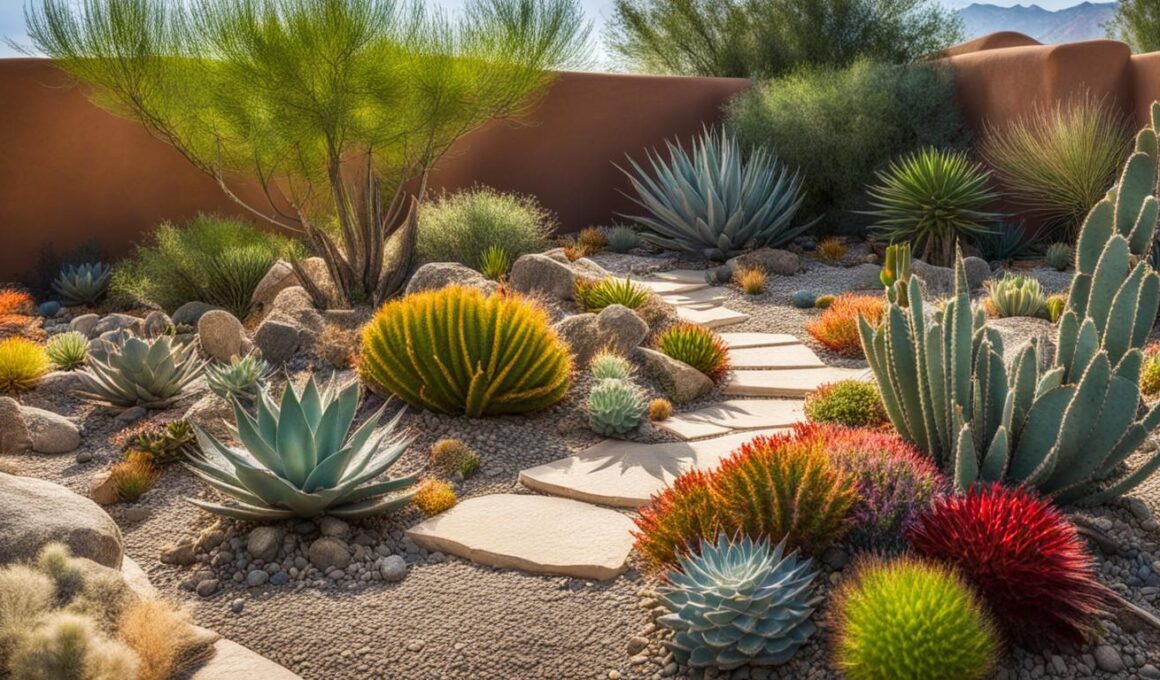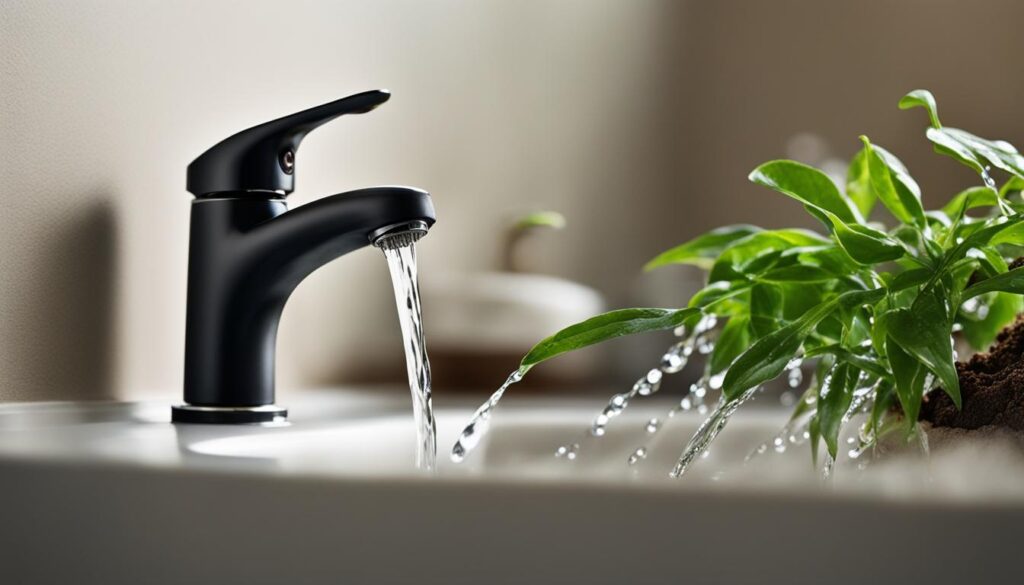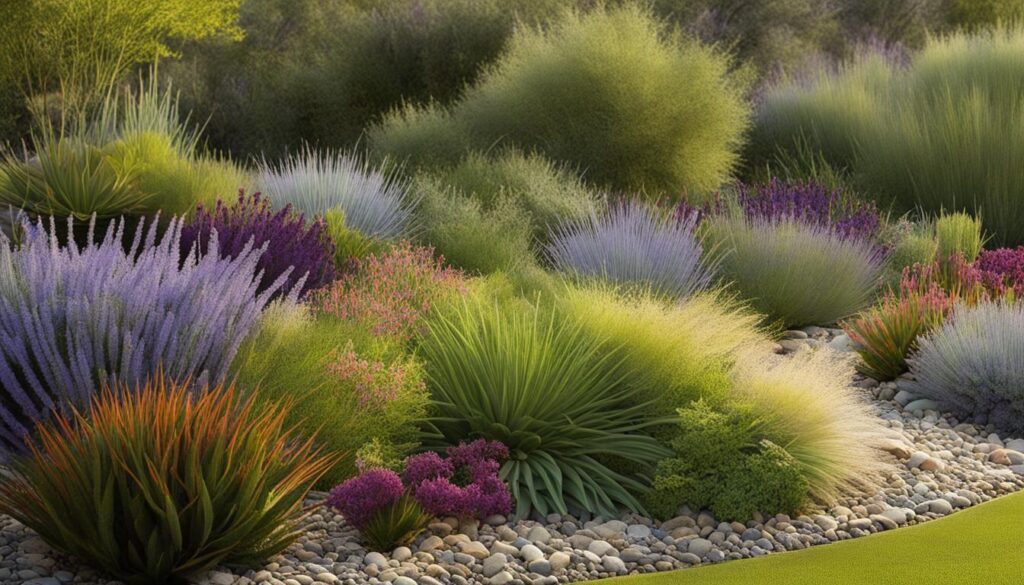Xeriscaping is a landscaping technique that allows homeowners to have a beautiful, diverse, and thriving landscape while conserving water. By using drought-tolerant plants and reducing or eliminating the need for irrigation, xeriscaping offers numerous benefits such as water and cost savings, time efficiency, and environmental protection.
Key Takeaways:
- Xeriscaping is a landscaping technique that helps homeowners conserve water while maintaining a beautiful landscape.
- By using drought-tolerant plants and minimizing irrigation, homeowners can save water and reduce their water bills.
- Xeriscaping also saves time and money by reducing the need for maintenance, such as lawn mowing.
- Implementing xeriscape principles, such as proper plant selection and efficient irrigation, is essential for success.
- Choosing native and drought-tolerant plants is crucial for creating a visually appealing and water-efficient landscape.
What is Xeriscaping and Why is it Important?
Xeriscaping is a type of landscaping that focuses on water conservation and sustainable practices. It involves designing and maintaining a landscape that reduces or eliminates the need for supplemental irrigation beyond what occurs naturally in the climate. By utilizing drought-tolerant plants, minimizing turfgrass, and incorporating native species, xeriscaping offers numerous benefits while promoting environmental responsibility.
The concept of xeriscaping was first introduced in the 1980s, during a period of drought in certain regions. The goal was to create landscapes that thrived without excessive water consumption. Today, xeriscaping has gained widespread popularity among homeowners in various climates, as it allows them to save water, reduce maintenance efforts, and support ecological balance.
Key elements of xeriscaping:
- Drought-tolerant plants: Xeriscaping involves selecting plants that are adapted to the local climate and can survive with minimal water requirements. This helps conserve water resources and promotes a sustainable landscape.
- Reducing turfgrass: Turfgrass areas require significant amounts of water to stay lush and green. Xeriscaping recommends minimizing or eliminating turfgrass in favor of alternatives such as drought-resistant groundcovers, mulch, or rocks.
- Native plant selection: Incorporating native plants into the landscape is a key principle of xeriscaping. Native plants are well-suited to the local environment and typically require less water, fertilizer, and maintenance.
- Efficient irrigation: Xeriscaping emphasizes the use of efficient irrigation systems such as drip irrigation or smart controllers. These systems deliver water directly to plant roots, minimizing water waste and supporting healthier growth.
- Mulching: Applying mulch around plants helps to retain moisture in the soil, reduce weed growth, and regulate soil temperature. Organic mulches also contribute to soil health as they decompose over time.
“Xeriscaping allows homeowners to create beautiful landscapes that are sustainable, environmentally-friendly, and require less water compared to traditional landscapes. By embracing xeriscaping principles, homeowners can contribute to water conservation efforts and enjoy a visually pleasing landscape that thrives with minimal maintenance.”
Implementing xeriscaping not only benefits homeowners by reducing water consumption and maintenance efforts but also contributes to the greater goal of water conservation and environmental protection. By adopting xeriscaping practices, homeowners can play an active role in creating a more sustainable future for themselves and future generations.
Benefits of Xeriscaping for Homeowners
Implementing xeriscaping techniques in your home offers numerous benefits that can positively impact your wallet, time, and the environment. Here are some key advantages:
Water Savings
Xeriscaping significantly reduces water usage by utilizing drought-tolerant plants that require minimal irrigation. By replacing traditional lawns with mulch or rocks, you can eliminate the need for excessive watering, resulting in substantial water savings. This not only helps conserve our precious water resources but also lowers your water bills.
Cost Savings
By reducing water consumption, xeriscaping can also lead to significant cost savings. With lower water bills and reduced irrigation system expenses, homeowners can allocate these savings towards other household needs or investments.
Time Savings
Xeriscaping requires less maintenance compared to traditional landscaping. Drought-tolerant plants typically require less pruning, weeding, and mowing, saving you valuable time and effort. Instead of spending hours on lawn care, you can enjoy your free time doing activities that you love.
Environmental Protection
Xeriscaping plays a vital role in environmental protection. By minimizing the use of water and harmful chemicals, you contribute to conserving water supplies and reducing pollution. Additionally, xeriscaping creates natural habitats for insects, birds, and other wildlife, promoting biodiversity in your local ecosystem.
Principles of Xeriscaping for Homeowners
Implementing xeriscape design requires following specific principles to create a sustainable and water-efficient landscape. By incorporating these key elements into your xeriscape plan, you can create a beautiful outdoor space that conserves water and minimizes maintenance. Here are the essential principles of xeriscaping:
- Planning: Start by assessing your landscape and considering factors such as sunlight, shade, drainage, and soil type. This will help you determine the best plant choices and design layout for your xeriscape.
- Soil Testing: Understanding your soil’s water retention capacity and nutrient content is crucial. Conduct a soil test to determine if any amendments are needed to create an optimal growing environment for your plants.
- Turfgrass Reduction: Minimize or eliminate the use of water-intensive turfgrass in your xeriscape. Instead, incorporate drought-tolerant plants that require less water and maintenance.
- Plant Selection: Choose plants that are well-adapted to your region’s climate and water availability. Native plants and drought-tolerant species are excellent choices as they require minimal watering once established.
- Mulching: Apply a layer of organic mulch around your plants to retain moisture, suppress weed growth, and regulate soil temperature. Mulching also helps prevent soil erosion.
- Proper Irrigation: Install an efficient irrigation system that delivers water directly to the plants’ root zone. Drip irrigation and smart irrigation controllers are excellent options for maintaining a water-efficient xeriscape.
- Maintenance: Regular maintenance is essential to ensure the long-term health and beauty of your xeriscape. This includes weeding, pruning, and monitoring for pests. Proper maintenance practices will help your xeriscape thrive with minimal water and effort.
By following these xeriscaping principles, you can create a sustainable landscape that not only conserves water but also enhances the beauty and value of your property.
Selecting Drought-Tolerant Plants
Choosing the right plants is essential for a successful xeriscape. Opt for plant species that are well-suited to your region’s climate and water availability. Native plants and drought-tolerant species are excellent choices as they have evolved to thrive in your local conditions. Here are some popular and versatile drought-tolerant plants:
- Agave
- Lavender
- Yarrow
- Sedum
- Penstemon
- Salvia
Remember to group plants with similar water needs together to maximize water efficiency and create visually appealing plant arrangements.
By selecting appropriate plants and applying these xeriscaping principles, you can create an attractive and sustainable landscape that requires minimal water and maintenance.
How Can Homeowners Properly Care for Their Xeriscaped Landscapes?
Homeowners can properly care for their xeriscaped landscapes by utilizing educational resources for homeowners. These resources can provide valuable information on water conservation, native plant selection, and proper maintenance techniques. By accessing these resources, homeowners can ensure that their xeriscaped landscapes remain beautiful and sustainable for years to come.
Recommended Plants for Xeriscaping
Choosing the right plants is essential for creating a successful xeriscape garden. Native plants and drought-tolerant species are particularly well-suited for this water-efficient landscaping approach. By selecting these xeriscape-friendly plants, you can ensure a thriving and visually appealing landscape while conserving water.
Here are some recommended plants for xeriscaping:
- Succulents: Succulents like aloe vera and jade plants are excellent choices for xeriscapes. They have the ability to store water in their leaves, making them highly drought-tolerant.
- Sedums: Sedums are low-growing, hardy plants that come in a variety of shapes and colors. They are known for their ability to survive in dry conditions, making them ideal for xeriscapes.
- Amelanchier: Also known as serviceberry or Juneberry, amelanchier is a native plant that adds beauty to xeriscape gardens. It produces delicate white flowers in the spring and berries that attract birds.
- Buddleia: Commonly referred to as butterfly bush, buddleia is a shrub that thrives in dry conditions. It not only adds vibrant colors to your xeriscape but also attracts butterflies and other pollinators.
- Feather Reed Grass: This ornamental grass is not only drought-tolerant but also adds elegant height and texture to xeriscape landscapes. It requires minimal water and maintenance.
Remember to group plants with similar water requirements to maximize water efficiency in your xeriscape. The selected plants should be well-suited to the climate and soil conditions of your region, ensuring their long-term success.
Conclusion
Xeriscaping is a smart and sustainable approach to landscaping that allows homeowners to create beautiful outdoor spaces while conserving water. By implementing xeriscape principles, you can enjoy the benefits of water-efficient landscaping and contribute to a more sustainable future.
With proper planning, plant selection, and maintenance, xeriscape gardens can thrive and flourish. By using drought-tolerant plants and reducing the need for irrigation, you can significantly reduce your water consumption and save on water bills. Xeriscaping also saves you time and effort, as these low-maintenance landscapes require less upkeep compared to traditional gardens.
Moreover, xeriscaping helps protect the environment by reducing the use of harmful chemicals and providing natural habitats for insects and wildlife. By choosing native and drought-tolerant plants, you can create a balanced and resilient ecosystem right in your own backyard.
So, embrace the power of xeriscaping and transform your landscape into a sustainable oasis. By incorporating xeriscape principles, you can enjoy a beautiful, water-efficient garden that not only saves you money but also helps preserve our precious water resources for future generations.













